SPECIAL EFFECTS // "THE GODFATHER TRILOGY" (1972-1990) |
"Blood On Their Hands"
| 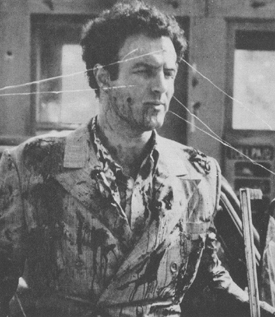 |
|
The term "special effects" refers to much more than matte paintings, computer-generated creatures and exploding spaceships. It can mean gunshots, ripped flesh, and lots and lots of blood. Fortunately there are film artists who balance technical sophistication and dramatic power with aesthetic restraint, and so the use of special effects to depict murder and mayhem can seem like more than mere bloodletting — at times it may achieve a kind of grandeur, and nowhere more so than in the GODFATHER series. For each episode of his GODFATHER saga, director Francis Coppola turned to a team of veterans to handle the chores of makeup and special effects, including:
The following interviews were conducted in the Winter of 1990 and Spring of 1991. Excerpts previously appeared in Cinefex Magazine. Also of interest is "A Shooting in New York," a step-by-step photo documentary of the staging of Joey Zasa's assassination in THE GODFATHER PART III.
 On Coppola: Flowers: He is one of the few directors who really sits down with his effects man or his set decorator, any person, on a one-on-one basis, and discuss what they can to; he discusses what he wants done, and if you can do what he wants then you devise a means of doing that. But Coppola does put a lot of preparation into each one of these scenes, and like that [stunt] on horseback (in Part III), I went up to his home in Napa last October, November last year, and we discussed some of the scenes and so he's had like a year to program these, to work them out. He was very thorough in that way. And so he does know what he wants. One thing that I have always admired about Coppola is, to me Coppola is a moviemaker; I believe if Coppola had the choice of making a beautiful, classic film, or making a million dollars, that he would rather make the film. I mean he wants something that is good, whereas you work with a lot of directors, they don't care what you do, they don't care how you do it, as long as it's fast and it makes money – the ones that add an explosion of a car because it's dragging or they show somebody going to bed together or something to gain attention to take your mind off the lousy story. Cavanaugh: He is spontaneous but normally I think he has a very good mechanical sense about him. He's been around mechanics a lot; his grandfather was a mechanical engineer, and he knows that you can't do certain things and make them right, and he won't do that to me. Which is a luxury, because there are a lot of directors who do try to push certain things on you that may either jeopardize the shot or put somebody in jeopardy. Francis is the best director I've worked with, my favorite, and I'd work with him for nothing! Lombardi: Actually how I got involved on THE GODFATHER is, Francis came one day down to the shop and I told him there's a couple of shots you should do. In the meanwhile I was rigging my son while I was talking to him, which he couldn't believe. And in about 15 minutes I put a bullet hole in his head and blew the back of his head [off], and I said, 'Francis, that's how you gotta kill Sollozzo.' Francis's big thing is 'Did anybody do it before?' 'No — first time.' 'Okay great, let's go.' On Filming: Lombardi: The big thing between Francis and I — especially when we did APOCALYPSE NOW — was, I did everything he wanted to do, and I did everything I wanted to do. He had nothing to lose. Where maybe he'd say I only wanted twenty five hits there, I'd come up with fifty; 'No, you should have fifty,' [I'd say]. We had the time to do it, so we did it. Smith: Certainly on GODFATHER I there was very little time for preparation. And because of the way Coppola works — he likes to be very spontaneous — things were kind of winged as we went along. There were certain things that would come up like last minute, and that's okay; that posed a problem sometimes, I mean like when they attempted to assassinate Brando in GODFATHER I and he's lying in the gutter, Francis told me the morning we arrived, he was
shooting, he wanted a couple of gallons of blood in the gutter. 'Francis,'
I said, 'I wish you'd let me know; I don't carry around, you know, gallons
of blood.' You didn't do it in those days — you had a little bottle. So
we had to scrounge around, send runners off to find Karo syrup and food
color and stuff like that and make up enough blood for the scene.
Shooting THE GODFATHER (1972)
On the Tollbooth Assassination of Sonny: Lombardi: Why go with five bullet hits when we can put 50? You know what I mean? Let's do something, and that's what happened on the killing of Sonny [James Caan]. We were only going to do a few, and we ended up with 80 body hits on him for that scene. When we set him up he had to come out of the car, and we couldn't get him out because we had a bundle of wire on him.
Lombardi: So what we did is, we took him all the ways to the front of the car, blew the whole thing apart, then we had a second car ready, and the toll booth we turned right around [it was fabricated so that they could re-shoot the scene with a fresh, unscarred backdrop] and we put him back in the car but now we had all the wires outside so we continued it and moved him out into the causeway, and that's how we did that shot. But the cameras were all locked off, and I defy you to find the cut. That actually baffled a lot of people. They couldn't believe it. Smith: Since there were so many hits that were supposed to be on him, I had created all these little "blisters" filled with blood which would be glued on, and each one had a little pop-top — a little round disc in the thin skin and a monofilament on it so that if you ripped them out a hole would appear and the blood would pour out of this blister. They were a bitch because they were the worst I ever created; they trended to leak, you had to make them ahead of time and then storage was difficult; getting them on was difficult — you could break one getting it on, it was like handling eggs. And what happened was, we get to shoot that scene and it gets late in the afternoon and we were losing daylight and something went wrong with the scene, it was not even complete, and to do them all over again there wasn't time before the sun went down to get another shot with those, so we abandoned them. So in the tollbooth there's not a single shot on the face; they're all on the body, which were of course done by the special effects people. You understand that the line between the makeup artist doing [bullets] and the special effects man doing bullets is that the makeup artist only does what is on skin, that show. Anything under clothing, that's his problem. I don't touch that. So the tollbooth was all body hits and I can't remember whether at the end maybe we put some blood on his face for a final shot but in the action there are no hits on [Sonny's] face. Lombardi: We looked all over for those cars. We finally found one in a barn in Pennsylvania, and we dragged it up there, it was the most beat-up thing it could be. We got in and we got ready to do the shot, and all of a sudden we're sitting in the back of it and a million ants came out, red ants, that we had brought in from Pennsylvania. Aw man! You should see going in there with extinguishers trying to freeze them out, killing and all that, all over you! On Michael Corleone's murder of Sollozzo and McClusky:
Then when the squib blew, it would blow a hole in the skin so the blood would pour out. The great trouble with that is it takes a lot of time to put it on, and when you finish, you have to take it all off, clean him up, and prepare him for another shot. It's very time-consuming and of course you could not only have something go wrong in the filming of the scene, you could have a squib be a dud or something. On the Murder of Moe Greene:
>Flowers: For the first time in my life, a director comes up to me [and says], 'You've got nearly all the time you want, you will have all the money you want to spend, let's kill somebody in a manner that's never been [done] before.' Now over the years in show business a person has been killed every way imaginable, that I've ever heard of. I mean, [in one story] they even made bullets out of ice, where they shot the bullets into somebody then the bullet melted. And of course they've been cut with knives and razors, and guns and clubs and everything. What is left? Well, that's where we came up with the idea of shooting Moe Greene in the eye through his glasses, which presented some problems. Smith: When the killer comes in [Greene's] lying on his stomach and he picks up his glasses and he puts them on. We cut to the killer and then when you cut back, they substituted the glasses.
Flowers: At the same time we blew air so that no particles of the breakaway glass would go into the man's eye. And with me and with I would say 99% of all the effects men our main concern is safety. You want to get a good shot, but you also don't want to hurt anybody. It was a safety precaution to add the air; the breakaway glass is actually plastic, but it does have chips in it. And this I had tried before but due to the time element of shooting — it was for TV — we never did get it properly. It's a tricky shot, and with a feature you have more time than you do with a [TV] movie. Even if it wasn't 100% original, for photographic purposes and for actual printing and using I believe that it was an original idea. Most of our effects are really combinations of what we have done in the past; in other words you combine ideas of your past experiences, take out what you feel is the best and go that route. And that I guess is one of the best scenes as far as the effects go in GODFATHER I. On the Car Explosion in Sicily:
And after that, they decided they should have an American effects man the next time.
THE GODFATHER PART II (1974) Smith: There were a couple of shootings in the forehead — we went through that again. There was this old bodyguard with the black hat and the almost white hair. He looked like Jean Gabin. You know that guy's a fantastic sculptor? That's what he really is. He did a lot of stuff for the Vatican. Yes, he gets shot in the hospital or something, and I did a newer kind of bullet hit effect on him. And there was somebody else. It really didn't amount to much. On the Attempted Murder of Don Fanucci, a Scene Cut from the Film's Theatrical Print:
Flowers: Yeah, well that was a scene where actually it didn't photograph as well as the story [required]. And this is one of the things which ruins effects, that often the camera goes away so fast from where it happens that you don't realize what is happening. An effects scene can't stay on too long, but it's got to stay on long enough to register. Like there, a guy's getting his throat slit, and he was supposed to put his hat underneath it to catch the blood dripping, and the scene was cut real short, and I don't think the audience really got that much out of it, and I think that was the main reason they cut it out. Smith: Eventually De Niro goes over the rooftops and goes in [to Venucci's building], and puts a gun in his mouth and shoots him. I had to make a duplicate of the revolver and make a rubber shaft on it, so he wouldn't hurt him. I mean, you take a regular metal gun and go like this, like you mean it? I mean, an actor could easily overact! On the Car Bombing in Cuba Scene: Flowers: It was around a lot of people so it had to be really prepared to where it looked like it was being blown up and still be safe. One of the locals that was helping us asked me, 'Hey, tell me how you did that; I could make a lot of money doing that.' I says, you could hurt somebody. And he says, 'Well that doesn't matter, I could make a lot of money doing that.' I didn't tell him anything! On the Revenge Killing of Don Ciccio in Sicily:
Lombardi: [De Niro] was a nervous wreck, but he did it all, cut the guy's belly right out. What was worse was my trying, in broken Italian, to explain to this old guy what we were going to do to him. He wanted no part of it! On the Hardships of Location Shooting: Smith: Yeah it was funny, because THE GODFATHER II I wasn't all that keen about working on it, but Francis was very enticing. He said 'I've written this so we're going to go to the greatest locations, we're going to have a great time,' and he was right. I mean we were first in Lake Tahoe which was very nice until it turned wintery, and then we came to New York City which was fine for me, [although it] was the worst location in a sense because you're in this miserable street down on the East Side. But still the crew was living in New York City so that ain't bad. Then we went to the Dominican Republic, which is not the greatest place in the world, the society's a bit primitive, but it was warm, there were beaches and so forth and it was very pleasant. In fact Al got sick and we had a week off, there was no shooting, so we had a vacation! My wife came down, so that was a pleasant location. Then we went to Rome, we were in Trieste for a few days which was great fun, and of course we were down in Sicily, mainly in Taormina which is a gorgeous little Northern coast town. Beautiful town. That was delightful. On the Effects of Violence: Flowers: Most of it was what we call bullet hits. There are some that are purely routine, but you generally try to add a little extra twist or a little this or that, and like the one (in PART III) where it shows it going through the body and into the glass, that's just a little added flavor that makes it more believable. Because most shows I think the effects men wouldn't have gone that extra yard to break the glass like that. So it shows that he cared and it shows that he put a little something extra into his work. That's another thing [about] Coppola — you do use effects for effect, but you also use effects to enhance the picture. If it doesn't really enhance the picture, some directors go ahead and put them in anyway, because they get lagging or something gets to dragging and so they go out and they blow up a car! But it has no rhyme nor reason to the show at all. Whereas Coppola, he doesn't want an added scene just because of an effect. Steinheimer: Both Larry and I were hoping for a little more blood effect [on Zasa's assassination]. But in the whole thing Francis is backing away from blood — I think it's anti-horse's head. He's going more for the acting element. Does that make it more difficult or less difficult for you? Steinheimer: The subtlety of what we do is more difficult. Yeah, he doesn't want a bigger effect; the effect is not the shot, it's the actor. So it makes it a little
bit more difficult. You can oversell the shot easily — just make it so
gory. The tone of this particular GODFATHER is not that; it's the subtlety
of the effect, in conjunction with the actor, which we're more used to.
Francis I think is hip that this is not a DIE HARD.
THE GODFATHER: PART III (1991) The Fate of Joey Zasa's Ear: Smith: The other thing is where Andy Garcia bites off the ear of his rival, a young Mafioso character in a fight, and so Joe Mantegna, sweet guy, came here and I cast his ear and so forth and made up this thing that would bleed and everything with a tip that would come off and so forth. God knows whether they used it or not. I think it was one of those things that they probably will decide 'This is too much.' To actually see someone go CRUNCH and PHEW, spit out a piece of ear, you know, I mean it's a little gross. At least he didn't chew it. With Francis you're always asked to do everything because he wants choices, which is fine; it's his prerogative. But you kind of have a suspicion that it's never going to get used. You can present an alternative to him but he will still say 'Do it my way also; we'll see it both ways.' On Vincent and the Two Intruders: Cavanaugh: One character [Andy] shoots in the chin — actually he puts the gun up to his throat and the trajectory runs through the top of his head and towards the back. And we rigged the gun in such as way, that we could put full loads of blanks in it. The fire, instead of coming out of the end of the barrel it would actually flash out of the chamber, and make a real beautiful red flash effect. But at the same time we had a mortar implanted in the back of the skull with a large chunk of the skull and the rubber skin which had hair on it, and that mortar was filled with a small explosive with blood, sponge, some strips of latex, all timed to the gun. In other words, when Andy pulled the trigger of the pistol it compressed a switch; when that switch was compressed, the gun went off, instantaneously it discharged and blew the back of the head off and then of course the back of the head blew up against the mirror and it had a lot of the discharge of the head onto the mirror, which was a little too gory . So we did it that way first, and then we changed it to where it was just straight blood. And that's the one you see. But that was a prosthetic head; Burman Studios made the head up, they did a beautiful job, it looked exactly like him. Then Andy turned around and [faced] the other would-be assassin, who is not armed except for a knife and he has his arm around Bridget Fonda and he has to do a little cut in her neck. Well, that was a knife we rigged up with the blood in the handle. He just had to put a little pressure on it and the blood would come out. At that point Andy starts to shoot him through the hand, which was a prosthetic latex piece over the palm of his hand, and the bullet goes through his hand and then hits him in the neck. Unfortunately it was shot so dark – Gordon Willis likes to shoot really low key — it didn't read really on screen. But it's still effective. It was actually timed off of Andy's gun, so the second that pistol flash discharges, everything goes off. There's a wire going up his sleeve running down underneath the carpeting, up to the guy's costume and then a secondary wire into his costume for the other squib. [Andy] has to really be accurate. The most important thing is that he shoots the gun just as he would a real gun, and has to aim exactly where he would be shooting, because the camera will read that it didn't really go there — especially over the shoulder, you really do notice it. We went through it with Andy. He is very, very good, he picks up things really quick, it wasn't too difficult to pretend that it's real, and virtually it is. 'It's scary,' he says. It's just like I shot him!' On the Assassination of Joey Zasa:
But the way the whole film's been — and that's the beauty of Francis — he doesn't know what he wants until he walks through a scene. You just have to be equally mercurial to adapt to what he kind of thinks, and then you have to outguess him. DICK TRACY was more laid out; you knew what you were going to be doing the next day. But there's a magic involved working with Francis that's hard to describe. He's what all of us wish we were, if we could be a director. He's mercurial, he's passionate. On the Mob Conference Hit in Atlantic City: Cavanaugh: It was [shot] in Rome at Cinecitta. That was huge. I would venture to say we had 4 miles of transmission wires under the stage, running up to different sections. We had sectioned it all off into different looms, and these looms of wires are like eight inches in diameter — they're like speaker wires. We probably had in excess of 3,000 squibs of different types and sizes. The way we choreographed it was all wrong for the way Francis shot it; the thing that was probably the most exciting about all of it was that we started the sequence, and Francis got really upset, he got very upset with the idea that we weren't including the actors; we were using stunt doubles. Normally you use a stunt double; he definitely did not want to do it, but it had to be safe at the same time. So we had a big discussion and had to tell him we could do it if we positioned the actors in exactly the right place, and took out some of the stronger explosives we were going to use. We actually did have Al and Andy right in the middle of all of those hits; they were literally in the middle of all of that. You could really see that. And there was stuff flying everywhere, but they didn't get hit. I have to be in very close contact with the set designer and the construction people, because almost all of the materials on that set were made of lightweight materials that wouldn't splinter, that wouldn't throw hard debris. Anything that looked [like] masonry was made of a material called pyrocell [spelling?], which is almost a chalky material. Once the squib goes off it just turns to dust. The banister and railings looked like they were made of marble; they were really made of a very lightweight material. Any wood products you see were made of balsa wood; any flat surfaces or wall surfaces would be [selatex] which is a paper product. These would actually be discharging out from the pyrotechnics — normally it just vaporizes before it makes any contact with anybody. But you can't tell that because we put a lot of dust in the hits at the same time, especially in the hits on masonry. We put a lot of cement or granite, colored dust to match. And then at times we'll accent that hit with a little spark. If it's hitting a piece of metal or something, it would ricochet. I don't like to do it too much. The guys are doing too much of it, I think. Now, everything sparks when you shoot a bullet. Rubber sparks! Because it's so easy to do! Most of the guys that were in there were squibbed, the secondary actors. I would say at least 20 were wired with multiple hits; a lot of guys just went down in the background. And again you couldn't see it because the lighting was low. To get the whole thing because we did it in very small pieces except for the master then, we went back in again and punched on individual pieces, we probably shot a solid week. It was supposed to be a helicopter hovering outside with the bad guys. Knowing that kind of firepower it had to be like an M-16 machine gun and a couple of Uzis or something coming from outside of the place to create that kind of havoc, but originally Francis didn't want the audience to know it was a helicopter except for the shaking on the set and then the soundtrack. But then he had to ID where it was coming from, because it was too mysterious. He did that in post-production. It wasn't a real big effects show. The luxury suite was the big effect, and we just had individual assassinations after that, and at the opera we had those killings, but they were pretty easy to do. On Actors: Steinheimer: You have to deal with a Method [acting style]. I have to say everybody's pretty much Method, which isn't judgmental at all, but there are certain people that you would trust and certain actors you wouldn't in certain situations. Without naming names, if you were going to use a trunion gun with a marble you wouldn't put it next to somebody who might move the wrong way; it might blow his head off if they don't move the same way every [take]. That's kind of a gray zone in effects; you have to judge the actors if they're trustable, if you can trust that they're going to move the same way every time, and if they do you can place them closer to danger. There was probably only one on the show that we wouldn't put into [that] shot. On Animals and Effects: Steinheimer: For Zasa's assassination we were blowing full loads over a horse's ear; that's a difficult one. That horse was very good, though. Horses are weird. I had a horse in one show, a great flop, Bill Cosby's first movie [LEONARD PART VI], and the horse was supposed to jump through a plate glass map. He was great on the first take, but the DP decided he'd like another shot of it, so to try to get a second take out of the horse was impossible. We had rehearsed the horse jumping through [plastic] months in advance, but after it went through glass — we blew the glass before the horse went through it — once the horse knew that it wasn't plastic, the second take was virtually impossible. He didn't want to do it. It wasn't a "method" horse? Steinheimer: No, it was a survival horse!
Postscript: |
copyright 1990, 1991, 1997, 2009 by David Morgan
All rights reserved.







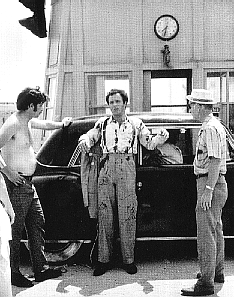

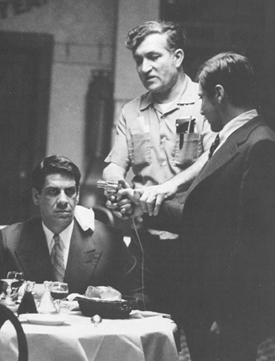
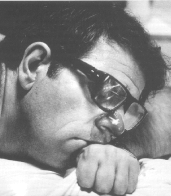 Now the glasses you remember were fairly thick, tortoise shell kind of thing, so they had two small tubes running along from behind the head along the stem towards the glass, and with air pressure they would first blow a tiny BB at high pressure through breakaway glass so that the force of the BB hitting it would be sure to explode outward and away. And the other tube contained blood and probably almost simultaneously one! two! the blood was squirted and it hit the broken glass. A.D. created all that. So you had that incredible effect where it looked like it was going out but it was really going in.
Now the glasses you remember were fairly thick, tortoise shell kind of thing, so they had two small tubes running along from behind the head along the stem towards the glass, and with air pressure they would first blow a tiny BB at high pressure through breakaway glass so that the force of the BB hitting it would be sure to explode outward and away. And the other tube contained blood and probably almost simultaneously one! two! the blood was squirted and it hit the broken glass. A.D. created all that. So you had that incredible effect where it looked like it was going out but it was really going in.
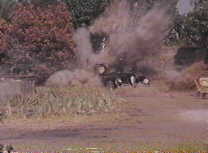 Flowers: That was an Italian effects man. He blew the car up but he was like a demolition expert; he blew it up! He didn't fool around with it. It was actually high explosives and it just went every place. But luckily nobody was hurt on it.
Flowers: That was an Italian effects man. He blew the car up but he was like a demolition expert; he blew it up! He didn't fool around with it. It was actually high explosives and it just went every place. But luckily nobody was hurt on it.
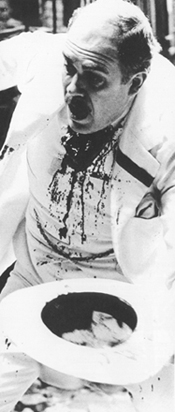 Smith: That was quite an effect. Bobby De Niro playing the young don, is walking through an alley and he observes this attempted assassination of the local Don. Which was this guy in the white suit, this guy was wonderful. Three young punks jump him and one of them on his back reaches around with a razor and cuts his throat. But he throws them off and they run away, and he reaches over and he picks up his white hat and he holds it under his bleeding neck which is spouting blood and he runs towards camera — the point of view is De Niro — turns to his right and runs down an alleyway and disappears. Now Coppola wanted that all on one shot on a master with this effect. [I made] a foam latex piece [which] A.D. Flowers rigged up with two canisters on the man's right side under his arm where it'd least likely show under his white suit: two canisters, one with compressed air and one with blood. and then he put a trigger or button in the palm of one hand that he could touch and that would set the thing going. I invented this thing, they've done a lot of them since, but we had a precut foam latex piece on here with little tubes underneath to pump the blood and it was just slightly stuck together with like sticky syrup so when the guy went like this, he would jerk his head up and make it split open, press the button and the blood would pump. Well, we shot this on a cold fall day, a miserable fucking day and like all these goddamn productions they had not enough white hats and white suits, you know they weren't really prepared, and Coppola's doing take after take, and we're going crazy, running out there trying to mop off the blood, and getting into a clean suit to make this thing work again and so forth. It was a hell of a day!
Smith: That was quite an effect. Bobby De Niro playing the young don, is walking through an alley and he observes this attempted assassination of the local Don. Which was this guy in the white suit, this guy was wonderful. Three young punks jump him and one of them on his back reaches around with a razor and cuts his throat. But he throws them off and they run away, and he reaches over and he picks up his white hat and he holds it under his bleeding neck which is spouting blood and he runs towards camera — the point of view is De Niro — turns to his right and runs down an alleyway and disappears. Now Coppola wanted that all on one shot on a master with this effect. [I made] a foam latex piece [which] A.D. Flowers rigged up with two canisters on the man's right side under his arm where it'd least likely show under his white suit: two canisters, one with compressed air and one with blood. and then he put a trigger or button in the palm of one hand that he could touch and that would set the thing going. I invented this thing, they've done a lot of them since, but we had a precut foam latex piece on here with little tubes underneath to pump the blood and it was just slightly stuck together with like sticky syrup so when the guy went like this, he would jerk his head up and make it split open, press the button and the blood would pump. Well, we shot this on a cold fall day, a miserable fucking day and like all these goddamn productions they had not enough white hats and white suits, you know they weren't really prepared, and Coppola's doing take after take, and we're going crazy, running out there trying to mop off the blood, and getting into a clean suit to make this thing work again and so forth. It was a hell of a day!
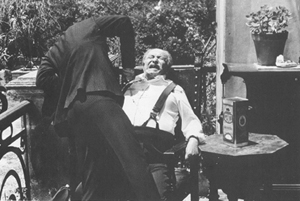 Flowers: We had to take a cast of [Giuseppe Sillato]'s stomach and from the cast we made a fiberglass protection plate for him. Then over the fiberglass protection plate we covered that with foam rubber. With that false belly, he looked like he was pregnant. When De Niro cut into him, we just pumped the blood right out. But no guts — we didn't go that far.
Flowers: We had to take a cast of [Giuseppe Sillato]'s stomach and from the cast we made a fiberglass protection plate for him. Then over the fiberglass protection plate we covered that with foam rubber. With that false belly, he looked like he was pregnant. When De Niro cut into him, we just pumped the blood right out. But no guts — we didn't go that far.
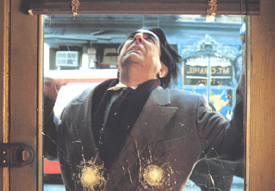 Steinheimer: [Coppola wanted to] see the effects of the bullets theoretically go through Joey and through the glass. It was a half-day's notice to put this
together. On the camera side you project glass balls fired through cannons;
the camera side is coordinated with the gunfire of Andy on the horse. But
the difficulty of it was to put it together on such [short] notice.
Steinheimer: [Coppola wanted to] see the effects of the bullets theoretically go through Joey and through the glass. It was a half-day's notice to put this
together. On the camera side you project glass balls fired through cannons;
the camera side is coordinated with the gunfire of Andy on the horse. But
the difficulty of it was to put it together on such [short] notice.